1996 PONTIAC BONNEVILLE overheating
[x] Cancel search: overheatingPage 119 of 387
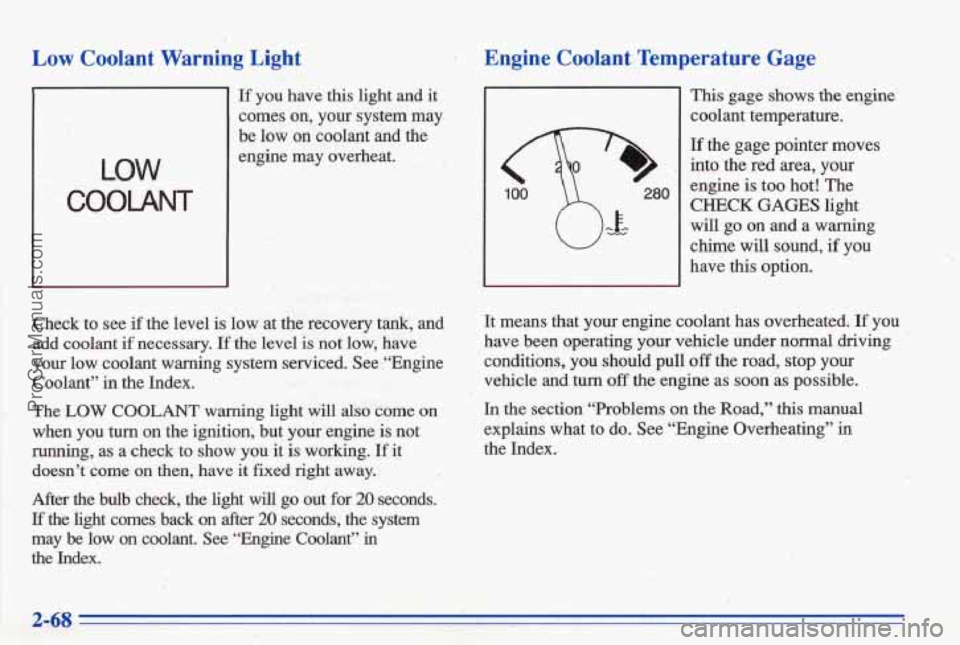
Low Coolant Warning Light
LOW
COOLANT
If you have this light and it
comes on, your system may
be low on coolant and the
engine may overheat.
Check to see
if the level is low at the recovery tank, and
add coolant if necessary. If the level is not low, have
your low
coolant warning system serviced. See “Engine
Coolant”
in the Index.
The
LOW COOLANT warning light will also come on
when you
turn on the ignition, but your engine is not
running, as a check to show you it is working. If it
doesn’t come on then, have
it fixed right away.
After the buIb check, the light will go out for 20 seconds.
If the light comes back on after 20 seconds, the system
may
be low on ,coolant. See “Engine Coolant’’ in
the Index.
Engine Coolant Temperature Gage
This gage shows the engine
coolant temperature.
If the gage pointer moves
into the red
,area, your
engine
is too hot! The
CHECK GAGES light
will
go on and a warning
chime
will sound, if you
have this option.
It means that your engine coolant has overheated.
If you
have been ‘operating your vehicle under
normal driving
conditions,
you should pull off the road, stop your
vehicle
and turn ,off the engine as soon as possible.
In the section “Problems on the Road,” this manual
explains what to do. See “Engine Overheating”
in
the Index.
, .-; ’.
. . -.
ProCarManuals.com
Page 204 of 387
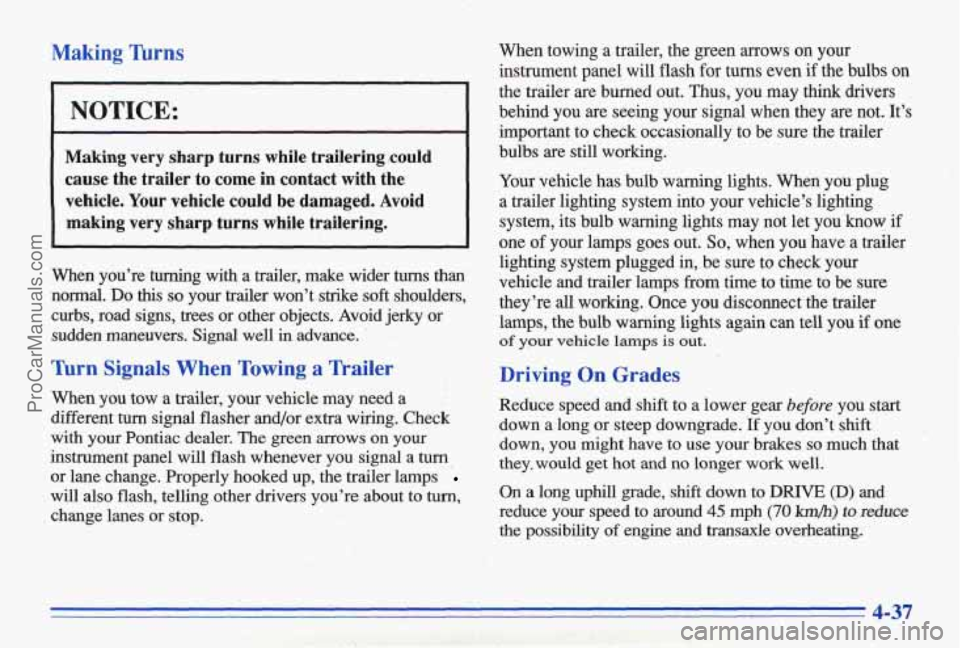
Making Turns
NOTICE:
Making very sharp turns while trailering could
cause the trailer to come in contact with the
vehicle. Your vehicle could be damaged. Avoid
making very sharp turns while trailering.
When you’re turning with a trailer, make wider turns than
normal. Do this so your trailer won’t strike soft shoulders,
curbs, road signs, trees or other objects. Avoid jerky
or
sudden maneuvers. Signal well in advance. ‘
. Turn ,Signals When Towing a Trailer’
When you tow a trailer, your vehicle may need a
different
turn signal flasher and/or extra wiring. Check
with your Pontiac dealer. The green
arrows on your
instrument panel will flash whenever you signal a turn
or lane change. Properly hooked up,’ the trailer lamps
will also flash, telling other drivers you’re about to turn,
change lanes or stop. When towing a trailer, the green arrows
on your
instrument panel will flash for turns
even if the bulbs on
the trailer are burned out.
Thus, you may think drivers
behind you are seeing your signal when they are not. It’s
important to check occasionally to be sure the trailer
bulbs are still working.
Your vehicle has bulb warning lights. When you’plug
a trailer lighting system into your vehicle’s lighting
system, its bulb warning lights may not let you
know if
one of your lamps goes out. So, when you have a trailer
lighting system plugged in, be sure to check your
vehicle and trailer lamps
from time to time to be sure
they’re
all working. Once you disconnect the trailer
lamps, the bulb warning lights again can tell you
if one
of ypur vehicle lamps is out.
Driving On Grades
Reduce speed and shift to a lower gear before you start
down a long or steep downgrade.
If you don’t shift
down, you might have to use your brakes so much that
they. would get hot
and no longer work well.
On a long uphill grade, shift down to Dm (D) and
reduce your speed to around
45 mph (70 km/h) to reduce
the possibility of engine and transaxle overheating.
4-37
ProCarManuals.com
Page 220 of 387
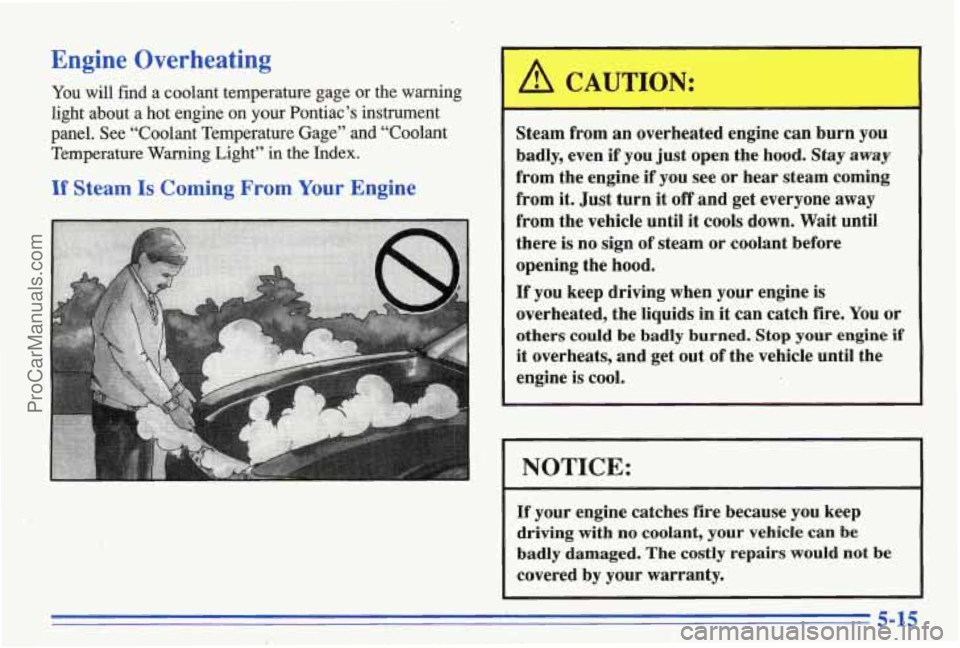
Engine Overheating
You will find a coolant temperature gage or the warning
light about a hot engine
on your Pontiac’s instrument
panel. See “Coolant Temperature Gage” and “Coolant Temperature Warning Light” in the Index.
If Steam Is Coming From Your Engine
I
Steam from an overheated engine can burn you
badly, even if you just open the hood. Stay
away
from the engine if you see or hear steam coming
from it. Just turn it
off and get everyone away
from the vehicle until it cools down. Wait until
there is no sign of steam or coolant before
opening the
hood.
If you keep driving when your engine is
overheated, the liquids in it can catch fire. You
or
others could be badly burned. Stop your engine if
it overheats, and get out of the vehicle until the
engine is cool.
I
NOTICE:
If your engine catches fire because you keep
driving with no coolant, your vehicle can be
badly damaged. The costly repairs would not be
covered
by your warranty.
5-15
ProCarManuals.com
Page 223 of 387
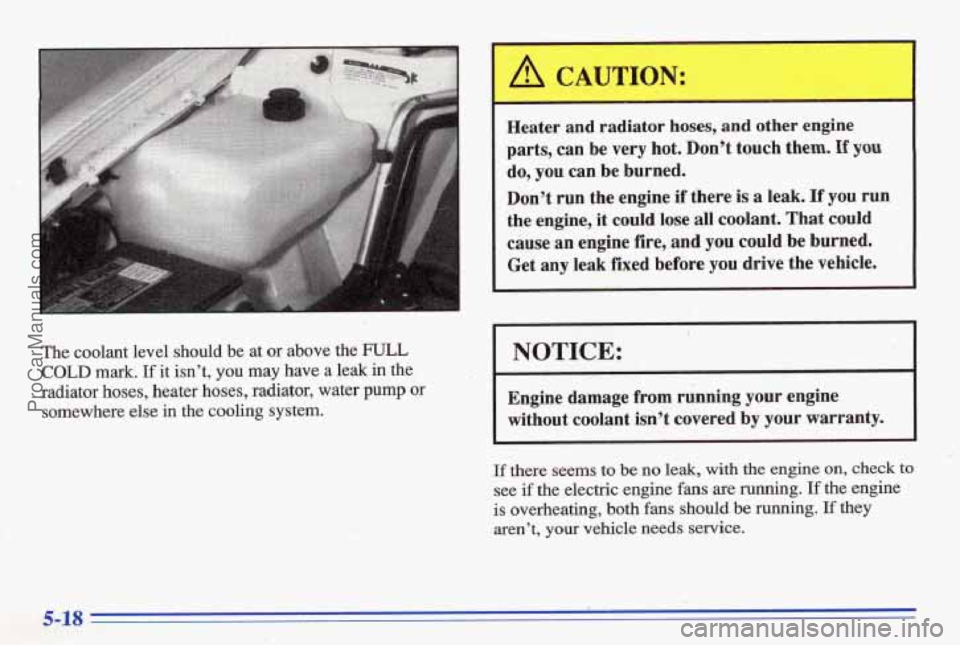
,
‘The coolant level should be at or above the FULL
% COLD mark. If it isn’t, you may have a leak in the
. radiator hoses, heater hoses, radiator, water pump or
somewhere else in the cooling system.
A CAWTION:
Heater and radiator hoses, and other engine
parts, can be
very hot. Don’t touch them. If you
do, you can be burned.
Don’t mn the engine
if there is a leak. If you run
’ the engine, it could lose all coolant. That could
cause an engine
fire, and you could be burned.
Get any leak fixed before you drive the vehicle.
I NOTICE:
I
Engine damage from running your engine
without coolant isn’t covered by your warranty.
I
If there seems to be no leak, with the engine on, check to
see if the electric engine fans are running. If the engine
is overheating, both fans should be running. If they
aren’t, your vehicle needs service.
ProCarManuals.com
Page 267 of 387
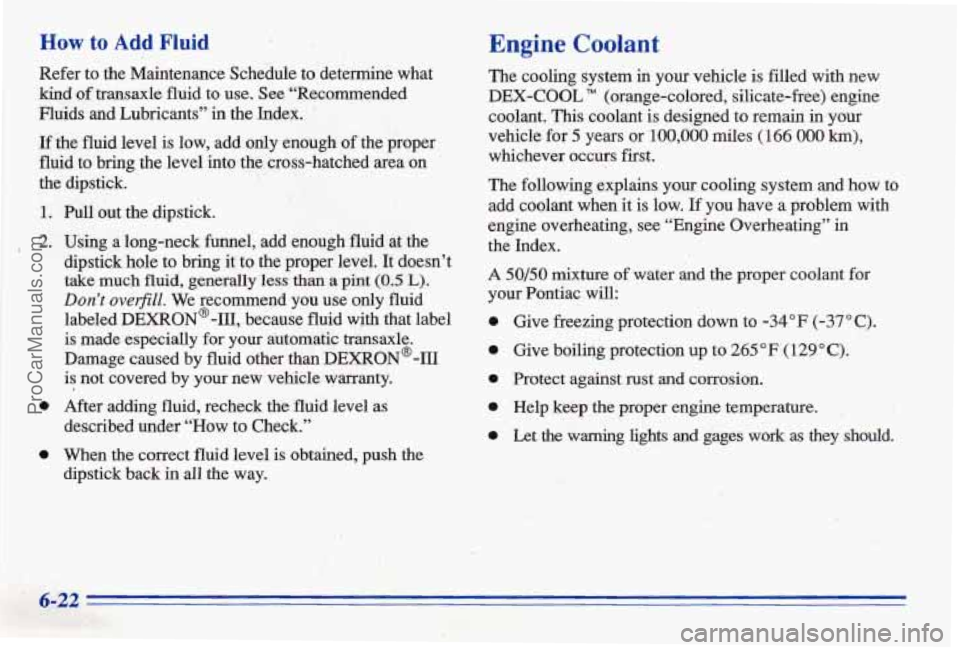
How to Add Fluid
Refer to the Maintenance Schedule to determine what
bind of tmhsaxle fluid to use. See 6‘Recomended
Fluids and Lubricants” in the Index.
If the fluid level is low, add only enough of the proper
fluid to bring
the level into the cross-hatched area on
the dipstick.
Pull out the dipstick.
Using a long-neck funnel, add enough
Md at the
dipstick hole to bring it to the proper level. It doesn’t
take much
fluid, generally less than a pint (0.5 L).
Don’t overfiI2. We recommend you use only fluid
labeled
DEXRON*-III,, because fluid with that label
is made especially for yo& automatic transax18e.
Damage caused
by fluid other than DEXRON’@-III
is not covered by your new vehicle warranty.
After adding fluid, recheck the fluid level as
described under “How to Check.”
When the correct fluid level is obtained, push the
dipstick back in
all the way.
Engine Coolant
The cooling system in your vehicle is filled with new
DEX-COOL (orange-colored,
silicate-free) engine
coolant.
This coolant is designed to remain in your
vehicle for 5 years or 100,000 miles (166 000 km),
whichever occurs first.
The following explains your cooling system and how to
add coolant when it is low.
If you have a problem with
engine overheating, see “Engine Overheating” in
the Index.
A 50/50 mixture of water &d the proper coolant for
your Pontiac will:
e
e
0
0
0
Give freezing protection down to -34°F (-37°C).
Give boiling protection up to 265 OF (1 29 O C).
Protect against rust and corrosion.
Help keep the proper engine temperature.
Let the warning lights and gages work as they should.
ProCarManuals.com
Page 271 of 387
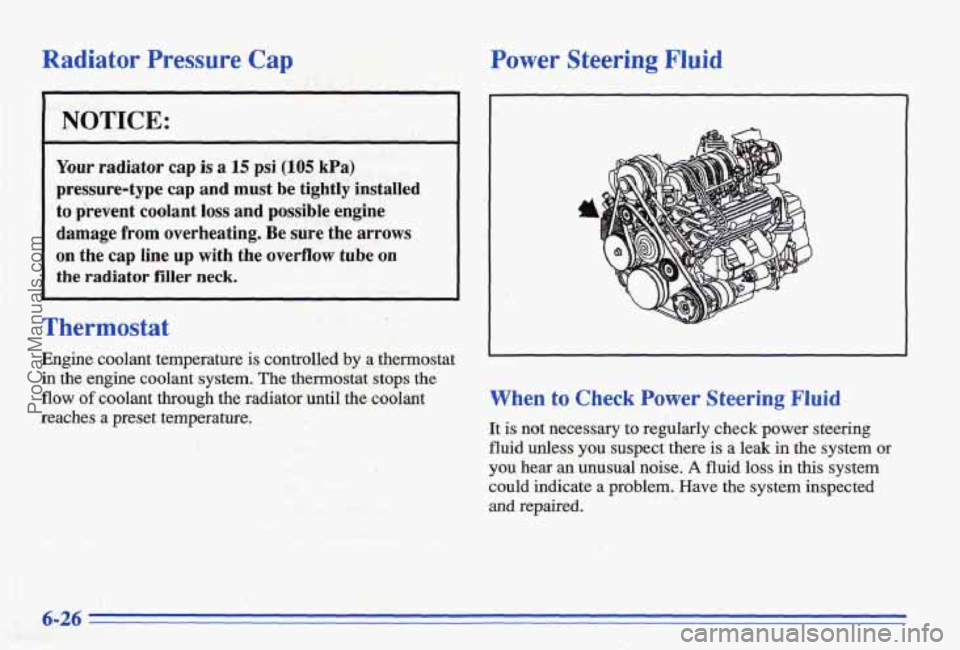
Radiator Pressure Cap
NOTICE:
Your radiator cap is a 15 psi (105 kPa)
pressure-type cap and must be tightly installed
to prevent coolant loss and possible engine
damage from overheating. Be sure the arrows
on the cap line up with the overflow tube on
the radiator filler neck.
1 I --$,. .: :; ' -%.Thermostat .
Engine coolant temperature is controlled by a thermostat
in the engine coolaxit system. The thermostat stops the
flow of coolant through the radiator until the coolant
reaches a preset temperature.
Power Steering Fluid
When to Check Power Steering Fluid
It is not necessary to regularly check power steering
fluid unless you suspect there is a leak in the system or
you hear
an unusual noise. A fluid loss in this system
could indicate
a problem. Have the system inspected
and repaired.
6-26
ProCarManuals.com
Page 286 of 387
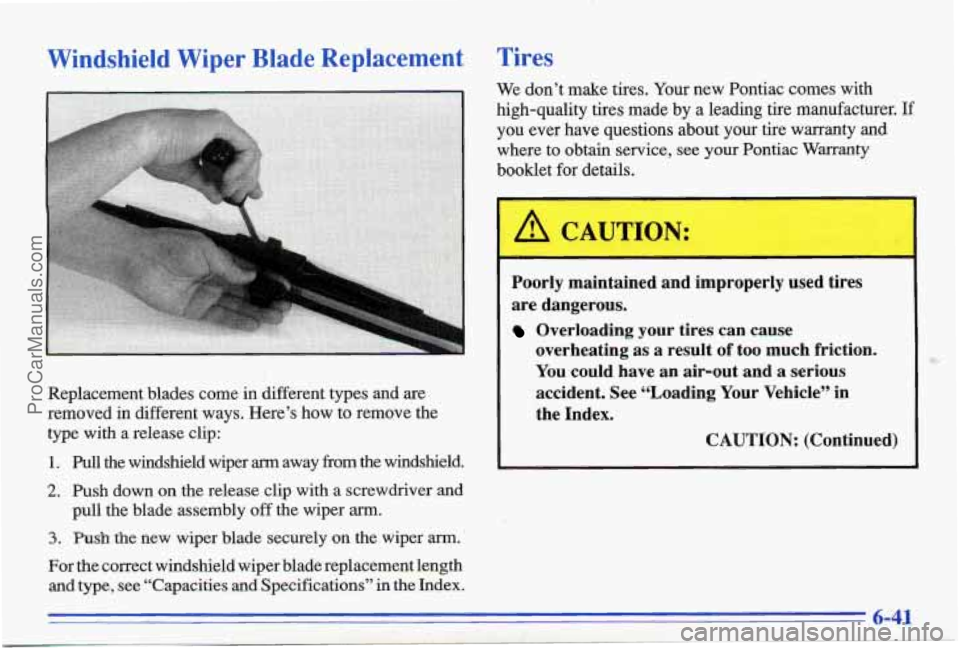
Windshield Wiper Blade Replacement
Replacement blades come in different types and are
removed in different ways. Here’s how to remove the
type with a release clip:
1. Pull the windshield wiper arm away fiom the windshield.
2. Push down on the release clip with a screwdriver and
3. Push the new wiper blade securely on the wiper arm. ’
For the correct windshield wiper blade replacement length
and type, see “Capacities and Specifications’’ in the Index.
pull
the blade assembly
off the wiper arm.
Tires
We don’t make tires. Your new Pontiac comes with
high-quality
tires made by a leading tire manufacturer. If
you ever have questions about your tire warranty and
where to obtain service, see
your Pontiac Warranty
booklet
for details.
1 A CAUTION:
Poorly maintained and improperly used tires
are dangerous.
Overloading your tires can cause
overheating as a result
of too much friction.
You could have an air-out and a serious
accident. See “Loading Your Vehicle” in
the Index.
CAUTION: (Continued)
6-41
ProCarManuals.com
Page 377 of 387
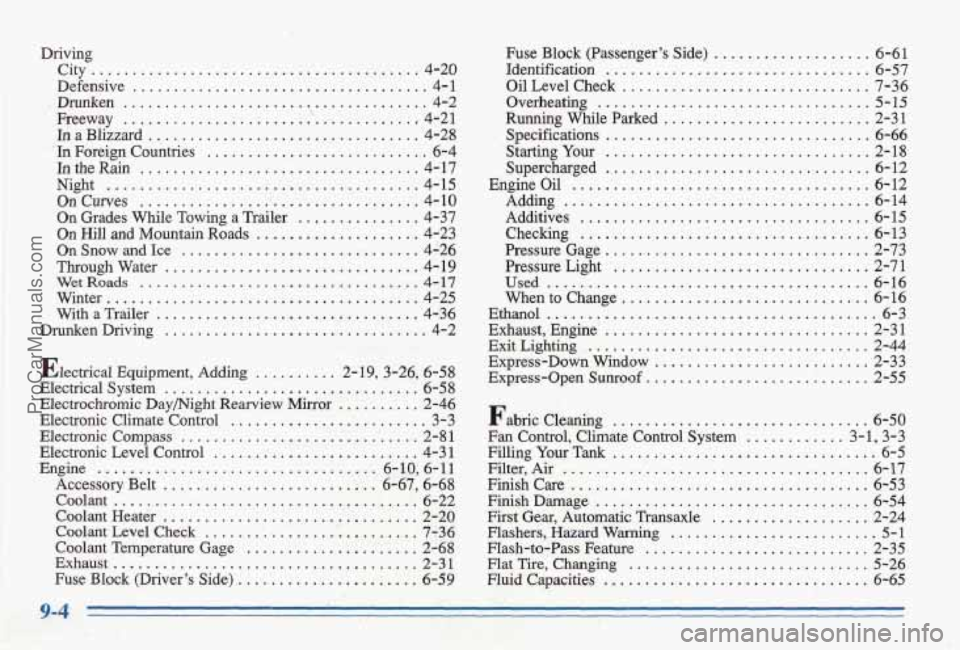
Driving City
........................................ 4-20
Defensive .................................... 4-1
Freeway .............. , ..................... 4-21
In a Blizzard .................................. 4-28
IntheRain .................................. 4-1.7
Night ...................................... 4-15
Oncurves ................I.................. 4-10
On Grades While Towing a Trailer ............... 4-37
On Hill and Mountain Roads .................... 4-23
On Snow and Ice .............................. 4-26
Through Water ................................. 4- 19
WetRoads ................................... 4-17
Winter ...................................... 4-25
With a Trailer
................................. 4-36
Drunken Driving ....................... ., ........ 4-2
. Drunken ...................... .,. ............. 4-2
. In Foreign Countries ............................ 6.-4
Electrical Equipment, Adding ........... 2.19.3.26. 6.58
Electrical System ........... :. .................. 6-58
Electrochromic Daymight Rearview Mirror .......... 2-46
Electronic Climate Control ........................ 3-3 .
Electronic Compass ............................. 2-8 1
Electronic Level Control ......................... 4-51
Engine ...................... , ............ 6-10. 6-11
Accessory Belt .......................... 6-67, 6-68
Coolant .... ’ ................................. 6-22
Coolant Heater .............. : ................ 2-20
Coolant Level Check ........................... 7-36
Coolant Temperature Gage ..................... 2-68
Exhaust ..................................... 2-31
Fuse Block (Driver’s Side) ....................... 6-59
Fuse Block (Passenger’s Side) ................. 6-61
Identification ................................ 6-57
Oil Level Check .............................. 7-36
Overheating ................................. 5-15
Running We Parked ......................... 2-31
Specifications ................................ 6-66
Starting YOW ................................. 2-18
Engine
Oil .................................... 6-12
Additives ................................... 6-15
Pressure Gage ....... .. ........................ 2-73
Pressure Light ............................... 2-71
Used ....................................... 6-16
When to Change .............................. 6-16
Ethan01 ........................................ 6-3
Exhaust, Engine ................................ 2-31
Exit Lighting ................................... 2-44
Express-Down Window .......................... 2-33
Express-Open Sunroof ........................... 2-55
Fabric Cleaning ............................... 6-50
Fan Control. Climate Control System ............ 3-1. 3-3
FillingYowTank ................................ 6-5
Filter. Air ...................................... 6-17
Finish Care .................................... 643
FinishDamage ................................. 6-54
First Gear, Automatic Transaxle
................... 2-24
Flashers. Hazard Warning .......................... 5-1
Flash-to-Pass Feature ........................... 2-35
Flat Tire, Changing ............................. 5-26
Fluid Capacities ................................ 6-65
Supercharged ................................ 6-12
Adding ..................................... 6-14
Checking ................................... 6-13
9-4
ProCarManuals.com